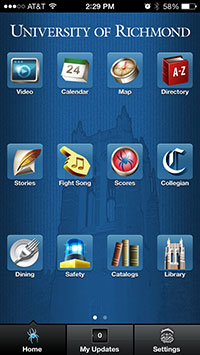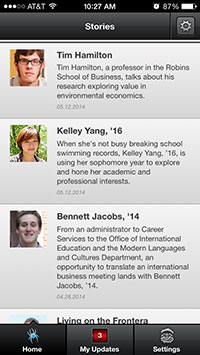A Mobile App Built on Centralized Content
In developing its own mobile app, the University of Richmond built a unified Web and mobile infrastructure that personalizes content for each user, eliminates silos and has resulted in a highly efficient use of resources.

U Richmond's mobile app home screen |
At first glance, the University of Richmond mobile app looks much like any other campus app, with all the modules you'd expect to see: Calendar, Map, Directory, Catalogs, Dining, and so forth. But this is no ordinary app. A "Stories" module offers a unique window into life at the university, and a "My Updates" feed is continually updated with content personalized to the user. An extensive "Settings" panel provides scores of options, allowing users to identify their university affiliation, areas of interest and preferred types of content, such as news, scores, stories, events and tweets.
What's more, all of the app's content is generated from a single, centralized source: the infrastructure underlying the university Web site.
"We believe that the modern way to think about mobile is to centralize your content and data as much as possible," said Phillip Gravely, UR's director of Web and editorial strategy. "Everything on the app is operating off the exact same content and data backbone as the Web site."
Centralization and Customization
"We set up our Web platform so that none of our content is in a separate layer," explained Gravely. "Instead of having separate content management systems and silos of content for Web, mobile and app, we built one central, single-source structure that drives them all. That provides a ton of advantages — ranging from brand management to content consistency to efficiency of staff resources."
The centralized approach makes it easy to keep content up-to-date, noted Eric Palmer, the university's director of Web services: "If it's fast-breaking news, we can do it in one place. For critical course information, such as catalogs, it's updated in one place. The information is not going to be different across different sites. This leads to more efficient use of human capital, and a lot of flexibility."
There are 120-plus sites within the university's Web ecosystem, including UR's schools, departments and administrative offices. When users download the app, they're asked to identify by audience — prospective student, alumni, faculty/staff, parent, etc. — and then select areas of interest. Those areas of interest can be around categories of content, such as arts or sports, or as specific as an individual academic department or a single sport. Gravely noted that the customization piece of the app is about content preferences and does not include personally identifiable information.
Once users select their preferences, Gravely said, "we leverage the centralized content infrastructure to deliver tailored information — specific content based on their preferences — to an 'Updates' wall in the app."
The unified infrastructure is of particular benefit to prospective students, who get access to content that resonates with them and fully ties into what they are seeing on the Web, Gravely noted. "So, in addition to being a set of functional tools, our app is a true extension of our content strategy."
Building the App
The UR team developed the app in-house using the Titanium Studio suite. "We used the free product, although you can pay for advanced features, support and training," said Palmer. "Using our existing developers and designers, we designed and coded the application 100 percent in-house. To help ensure a faster start-up, several members of the team attended a Titanium Studio training class."
He added, "It wasn't easy, but we had a very talented staff, with technical depth and design savvy. The outcome speaks for itself, since we have been contacted by other schools and asked, 'Who developed your great smartphone app?'"
Developing a mobile app in-house can have a significant learning curve, warned Palmer. While the basic Titanium Studio suite is free, the process of using it took up valuable staff time. "My team put in 80 hours working on the backend data structure, and other members of the team put in several months of part-time work on the app itself," he said. "Titanium Studio is a very solid tool that does an amazing job of generating both native iOS code and Android code. But screen resolution differences exist in developing apps that work both on Apple and Android devices." Of course, these challenges exist regardless of the tool chain used, said Palmer. "Given the overall outcome, we would gladly choose Titanium Studio again for a cross-device development effort."
The development team worked with colleagues across campus to understand what they need and build it into the central app. "Instead of 25 apps, we have one app with an ever-increasing number of modules within it," explained Gravely. "For instance, a vendor approached our police department about a separate app for safety functions. Knowing our philosophy, the department contacted me to let me know they liked the idea. So we built a 'Safety' module into the central UR app, and they didn't spend money or build a separate content silo. Plus the user experience is better."
Logistics and Storytelling
Current students use the UR app — which will be updated this summer and fall — mainly for logistics-based information: facility hours, dining menus, directory information, upcoming events, etc. Alumni are the second largest audience for the app, followed by prospective students and their parents.
"As you move into the other audiences," Gravely explained, "we see more interaction with the 'storytelling' types of content, in addition to the logistical. And that makes sense. Those more familiar with the brand are more likely to just use the tools — whereas those less familiar are interested in learning about the experience through the stories."

The app's Stories module provides a taste of life at the university. |
The app's "Stories" module presents articles about people and events at the university, including interviews with professors, students and visiting scholars, designed to give readers a taste of life at the school. The UR philosophy is to emphasize storytelling over marketing, said Gravely. The editorial staff is charged with going out and finding stories, and there is a form online for members of the community to submit their own story ideas.
"Consumers don't respond to hyperbolic marketing messages," he explained. "They respond to stories in which they can learn about the experience and form their own conclusions. We seek to create, curate and deliver the content in the most authentic way possible. We're not fabricating stories. We're just capturing them and passing them along. People respond really well to that. It's real, and it's delivered in a deep and consistent manner, regardless of device."
Branding Matters
"From a brand perspective," Gravely observed, "we can't overstate the importance of having a centralized, single-source content and data infrastructure, as well as a unified design system. This gives us full control of the brand and how it looks." He emphasized that there are many vendors offering this kind of service, "but only so many variations on design." An in-house design offers endless possibilities.
"We believe that our method of streamlining and centralizing information is the most effective way to build an app, and a Web site," added Gravely. "It gives us tighter control of the brand, and it's on the cutting edge as far as modern Web and app usage is concerned."
Gravely concluded: "If I were to give one piece of advice, it would be to think about your Web, mobile Web and app as a single entity. Create a unified, central content and data ecosystem and a design system that delivers that content in a responsive way. Don't work with a lot of silos. Centralize as much as possible. This is best for the user, and this is best for efficiency. Despite the enormity of the task, the payoff — if you commit — will be there."